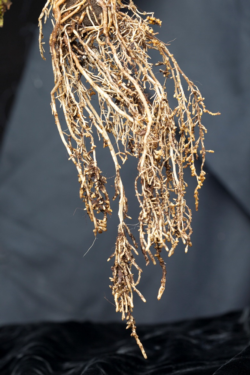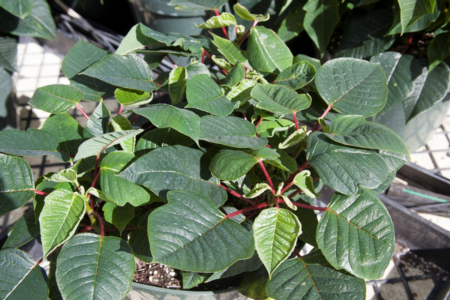Fall 2013 Field Observations: Diagnosis of a poinsettia problem
by Steve Tjosvold
Ahhh, poinsettia season! It is usually a grower’s nightmare crop. If everything is going well with your poinsettia crop, then you better start to worry. Case in point is a recent observation of a very interesting problem with a poinsettia crop — an experience for all of us to learn from.
“Wondering if you ever saw nematode on poinsettia?” I asked UC nematologists in a late afternoon email that accompanied the picture of roots of the potted poinsettia that I received at my office from a grower earlier that day (see fig. 1). After some email discussion between 5:50 and 10:32 that night (what else do nematologists do?), the conclusion was that the root galling really did not look quite like root knot nematode. One nematologist noted, “A nematode, probably root knot, was a major problem in southern California in the ’70s.” Another nematologist commented, “Meloidogyne spp. (root knot nematodes) are the only nematode pathogens listed infecting poinsettia by APS (American Phytopathological Society) and the root galls look funky.” (Funky is a nematologist’s term used when the root galls don’t really look like they are caused by nematodes.)

Fig. 1. Poinsettia roots with soil removed showing root galls and stunting. Photo by Steve Tjosvold.
I broke into several galls on the roots with the aid of a stereomicroscope, but could not find the glistening, roundish, female nematodes that can normally be seen with root knot nematode infestations. I placed some of the galled roots into a petri plate and sprayed with deionized water and the next morning nematode larvae were swimming in the water surrounding the roots. The plot thickened! I sent samples to UC Riverside where another nematologist cultured the nematodes out of the root and soil tissue for identification. The plot flops! These were saprophytic nematodes, not pathogenic nematodes. (Yikes, if only I had made the time to look at my nematodes in a light microscope to search for the stylet mouthparts that pathogenic nematodes use to puncture and feed on plants!)
And now for the rest of the story…There were aboveground symptoms that were actually more problematic for the grower than the root nodules. Younger leaves were cupped upward, with edges almost folded in the worst cases, and chlorotic. There was an overall loss of vigor (see fig. 2). Leaf distortion was apparent in less than 1% of all pots and with no obvious patterns of distribution in the greenhouse, but when it was occurring, all 3 plants per pot were affected. When there were strong aboveground symptoms, there was also root galling to some extent. Cycocel growth regulator (chlormequat chloride) and a drench of Distance insecticide (pyriproxyfen) was applied earlier in the crop. The growing points and leaves did not have any broad or cyclamen mites. No other diseases were seen.

Fig. 2. Poinsettia leaf cupping and distortion on newest growth. Photo by Steve Tjosvold.
Found on page 8 of the Distance label (2010-DIS-0001) was the following:
Drench Application to Individual Pots of Poinsettia: In a few instances, malformation of roots and newly expanded leaves (i.e. cupping) has been observed on certain Poinsettia varieties (i.e. Freedom Bright, Freedom Bright Red, Winter Rose, and Jingle Bells) following drench application of Distance. Leaf malformation was more commonly observed on plants exposed to high air temperatures and on plants whose soil media was allowed to dry out following application, such as those along walkways or near doorways…
So we will never know for sure. The variety affected was ‘Prestige Red’ so, in this case, it was not listed specifically on the label. All of the plants received Distance, but maybe the low incidence and nonuniformity of symptoms might be explained by a small percentage of the plants being predisposed by one of the soil moisture or high air temperature triggers. Maybe plants got a bit too dry before the hand application — and inherently nonuniform — soil drench of Distance.
A representative of Valent, the manufacturer of Distance, said they had some experimental evidence that the EC formulation might be causing the occasional problem and not the active ingredient in Distance. They did not know the mechanism.
Interestingly, I was listening to Don Merhaut of UC Riverside speaking at a recent UCNFA meeting about calcium deficiency symptoms. Don noted “Calcium deficiency can cause leaf deformation and root malformations among other symptoms, and this can be accentuated by irregular watering…” Yes, the plot thickens again! Could this be an induced calcium deficiency? Unfortunately, the grower had previously sent a soil and tissue sample in for laboratory nutrient analysis and found that “all mineral nutrients fell into normal ranges.” So does the plot flop again? Maybe not, because there was no sample analyzed for healthy tissue or healthy plants, only plants with symptoms. Even though we sometimes have standardized normal ranges, as for poinsettia, there is a lot of variation in the analysis due to sampling and laboratory procedures. It is best to have at least one composite sample each of healthy and unhealthy plants when diagnosing nutritional disorders. Talk to your laboratory to make recommendations on which leaves to sample. In this case, the laboratory was recommending “recently matured leaf tissue” to sample.
So why is the mechanism of action here so important? Well, for one thing Distance is a valuable and unique pest management tool for poinsettia production and if we understand the mechanism of this toxicity, then we might be able to better control it without changing the formulation. For example, if we find calcium or calcium metabolism is the real culprit of the distortion symptoms, then maybe we could focus on reducing that factor, such as how growers do for blossom end rot in tomato or upper leaf scorch in oriental lilies, both caused by calcium deficiency.
At the time of this writing, samples from healthy and unhealthy plants will be analyzed for mineral content. So we will see. I hope these observations illustrate how the diagnostic process can be imperfect and the steps the grower and I must take to improve our chances of pinning down a proper diagnosis and management strategy.
Steven A. Tjosvold
Farm Advisor, Environmental Horticulture
UC Cooperative Extension Santa Cruz County
1432 Freedom Boulevard, Watsonville, CA 95076-2796
(831) 763-8013 phone, (831) 763-8006 fax
satjosvold@ucdavis.edu
http://cesantacruz.ucdavis.edu












